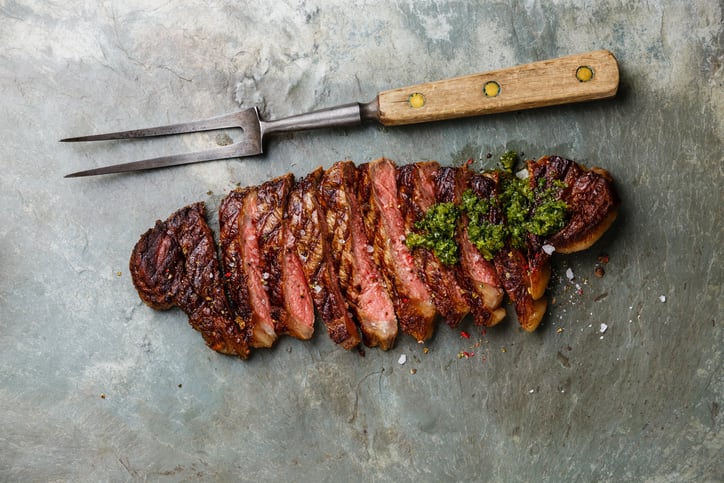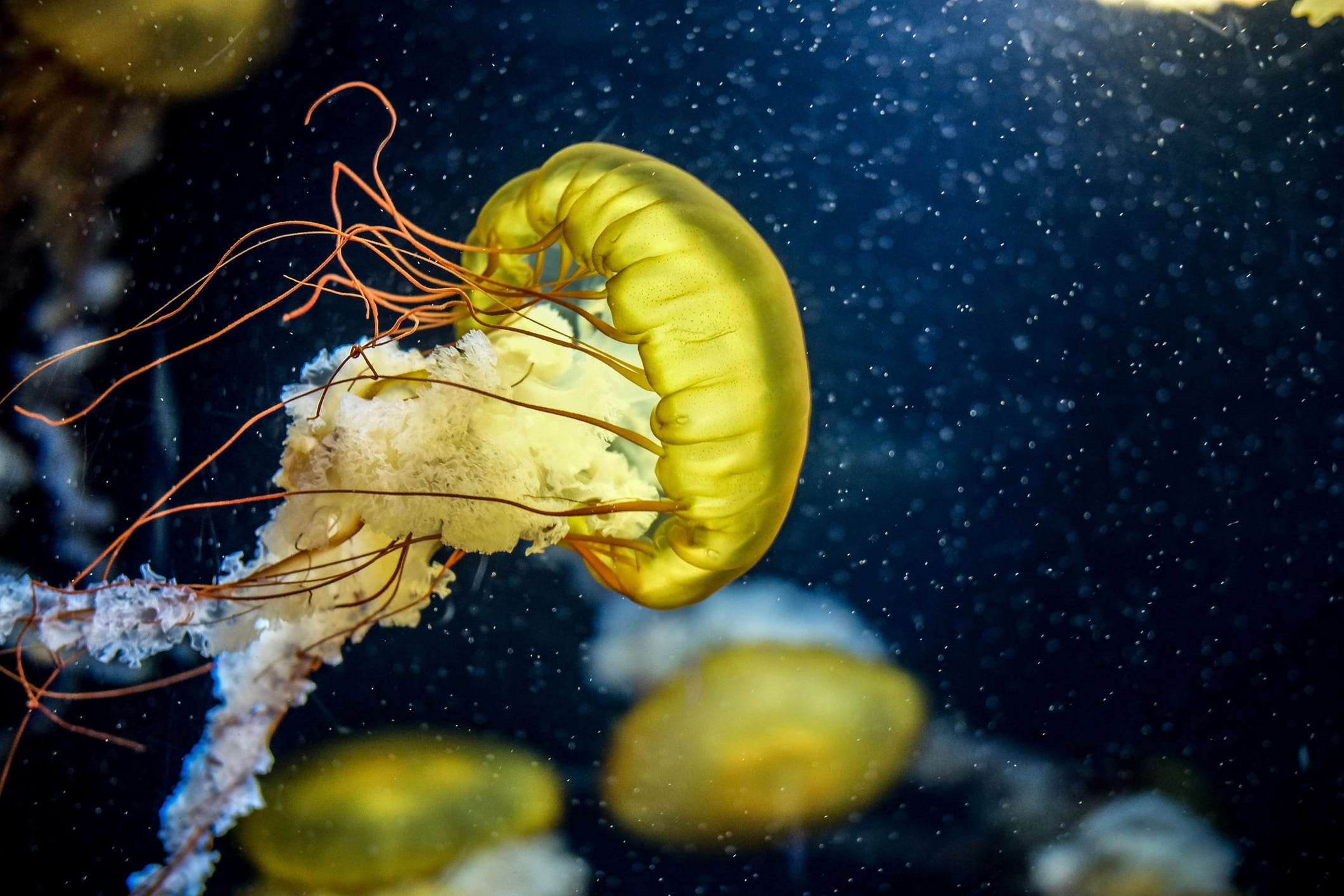Published by the supermarket to mark its 150th birthday, it painted a picture of life in 2025, 2050 and 2169, and predicted the evolving face of food for the next 150 years.
“By looking at the macro trends, scientific studies and heightened environmental awareness already developing today, we can start to explore how our food could start to change in the future and what that might mean for our customers,” it said.
It noted how the world’s eating habits, technology and food sourcing had changed “immeasurably” over the last 150 years. Sainsbury’s now sold more avocados (which it first introduced to UK shelves in 1962) than oranges, it revealed.
Among the most eye-catching developments was jellyfish, which together with “other ‘invasive species’ could be found on the fish counter as recent research has found them to be full of nutrients and vitamins," it predicted.
“And we could even be introducing a ‘lab-grown’ aisle, where people can pick up cultured-meats and kits to grow meat at home. Meat, as we know it today, could instead start to become a luxury product.”
Lichen – a fungus that grows on rocks on trees – will be sold in supermarkets in 2025, anticipated the report. It added that consumers would likely to be consuming key nutrients through implants, while nutrition patches and drips could replace our day-to-day intake.
Scientists may be farming in space, and in just five years’ time doctors could be giving food advice alongside medication, it suggested.
‘After the decline of abattoirs in the UK in the 2040s’
The report envisaged slaughterhouse numbers decreasing in the UK in the 2040s, replaced by farms making lab-grown meat. “At one end of the property is a farm, cultivating plants that will provide the growth serum in which cells are developed. At the other, giant meat-growing vats lead to a small conveyor belt where the meat is ‘assembled’ with 3D printing technology,” it wrote.
As the global trend for meat consumption increased, Briton’s are changing their diets to eating less meat, noted Sainsbury’s. Flexitarians, or those actively reducing their meat consumption, make up a fifth of Britons. Vegetarians account for an eighth. Vegans are still in the minority at around 600,000 in the UK.
“However, with the rise of an ecologically aware new generation, driven by health concerns and environmental determination, vegetarians (including vegans) look set to make up a quarter of British people in 2025, and flexitarians just under half of all UK consumers,” it predicted.
Paul Shapiro, author of Clean Meat, How Growing Meat Without Animals Will Revolutionize Dinner and the World, said: “It’s tough to predict 30 years into the future, but we do know this: we’re going to have to produce a lot more food with fewer resources in 2050 than we do today. The thought that we’ll produce meat (which is very resource-intensive) the way we do today is unrealistic. Far more likely is that we’ll be making meat from plants, as well as culturing it from animal cells. That’s not to say we won’t have any meat from slaughtered animals, but it will no longer be the dominant form of meat.”
A ‘sin tax’ on meat?

An upshot of the move away from meat was a possible ‘sin tax’ on it in the near future, claimed the document. “Meat taxes have already been discussed in parliaments in Germany, Denmark and Sweden and China’s government cut its recommended maximum meat consumption by 45% in 2016,” it wrote.
However, this is something ruled currently out by the current UK Environment Secretary Michael Gove.
He said: “Sustainable farming, particularly mixed and livestock farming, is a critical part of ensuring we have a healthy environment.
“One thing we absolutely do not want to do is use a crude taxation intervention when it is much more sensible to work with farmers to raise the quality of livestock.
“There are things we can do on how livestock farmers operate which can contribute to reducing emissions, while at the same time maintaining high-quality red meat which is available to people at every price point.”
New ways of farming
Sainsbury’s identified growing opportunities for the hydroponics sector. IKEA, for example, early in 2019, announced a pilot to cultivate hydroponic lettuce on site to supply its restaurants in Germany and Sweden.
“The latest food developments may appear completely new but very often they are just the latest iterations of trends which emerged in the past thanks to a range of economic, social and political influences,” said food historian Dr Polly Russell.
“The current search for alternative proteins - beyond traditional meat and fish - is one such trend. In the late nineteenth century, for instance, scientists like Baron Von Liebig sought to feed expanding industrial populations by developing pioneering processing technology to produce “liquid beef” (products we know as stock cubes and brands like Bovril).”
Algea, seaweed and insects whet investor appetites
Mushroom-based products, algae milk, seaweed caviar and insects were just some of the increasingly sophisticated options whetting investor appetite, believed the report, thanks to scientists calling for a change in our diets and the way we consumed our protein.
Insect and algae protein sources represented a potential viable, sustainable and radically less resource-intensive alternative to conventional livestock feed, said Sainsbury’s, which was the first UK supermarket to introduce snack-packs of insects through the brand, Eat Grub.
Chicken was once rich-people's’ food
In the past technology has led to great shifts in our diet. A great example is the rise in popularity of chicken, explained Claire Hughes, Head of Quality and Innovation at Sainsbury’s. “In 1948 just two per cent of households in Britain owned a fridge, making it impossible to safely store perishable food such as vegetables, dairy and chicken. But even in 1959, only 13 percent of homes had a refrigerator. While the adoption of refrigerator technology in the home was taking place, chicken was seen as an elite food and was expensive. Then, the cold chain revolution happened. By 1965, retailers such as Sainsbury’s dropped the price of poultry by nearly a third, recognising it was a good alternative to red meat and could be produced to feed a growing nation. This caused demand to soar and 25 years later almost a quarter of the meat eaten in Britain was chicken or turkey.”
Lesser-eaten fish species will appear in kitchens

Changes taking place in the oceans and the issues impacting the sustainability of fishing would be a major consideration by 2050, declared the report. This will see demand increasing for lesser-eaten species such as porgy/bream, dogfish, lionfish and barramundi, as consumers discovered previously overlooked nutrient sources and exploited the abundance of invasive species.
“In recent years, jellyfish blooms, caused by warmer, more acidic oceans with reduced numbers of predators, have become a source of concern for communities and industries near the coast,” said Sainsbury’s. “Jellyfish are typically regarded as a last resort food source, but the growing interest of researchers and seafood chefs is triggering a re-think.”
Its analysis cited a team of Danish researchers who devised a method to turn jellyfish, which are rich in nutrients, including vitamin B12, magnesium, and iron, and low in calories, into crunchy chips in just a few days. “Fast-forward to 2050 and jellyfish could provide a regular nutrient-rich addition to our supper tables and the basis for many dried ingredients and sauce mixes found on the supermarket shelves.”
Anything, anywhere, anytime
Food production and consumption will be taken to a whole new level driven by real-time information in the future. The study reckoned that delivery lorries distributing online shopping might well be replaced by drones, driverless cars, or even by robot home assistants.
“Today’s algorithms and Artificial Intelligence (AI) capabilities tend to be smart calorie counters and nutritional advisors for people wanting to achieve a certain weight or fitness goal, but the connected world of 2169 could see our AI personal nutrition advisors shop, prepare and tailor meals to optimise our health, ensuring that we only use exactly what we need, with food waste a thing of the past.”
Today’s cutting-edge trends will be mainstream products
Many food companies are already exploring the use of blockchain technology to allow a complete tracking and tracing capacity in the food supply chain. Using the latest mobile technology, consumers can already scan products on the shop floor to bring up information about the origin and journey of food and other products they are interested in purchasing. This additional layer of intelligence was likely to become increasingly common in 30 year’s time, believed Sainsbury’s.
“Uniform, mass production and marketing will have fallen out of favour and food will be highly tailored to each individual customer. With every customer having their own Food ID, diets could be extremely customised, with fruit such as mangoes offered to us at our preferred stage of ripeness, and 3D printed savoury snacks on demand according to our exact spice tolerance. Systems will record and analyse food preferences with user inputs and real-time biometrics.”
The report concluded: “Contrary to the dystopian future drained of humanity that is imagined by many, the combined force of personalised optimisation and farming impossible environments carve a path for how we can cut food waste, bring deserts back to life and celebrate our humanity through the act of eating.”


